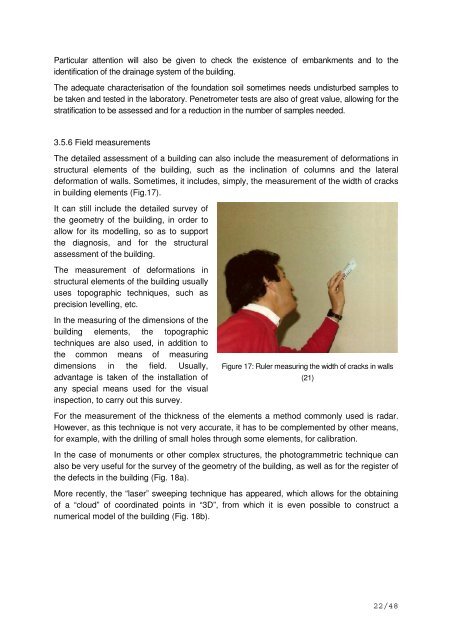Guide for the Structural Rehabilitation of Heritage ... - Test Input
Guide for the Structural Rehabilitation of Heritage ... - Test Input
Guide for the Structural Rehabilitation of Heritage ... - Test Input
Create successful ePaper yourself
Turn your PDF publications into a flip-book with our unique Google optimized e-Paper software.
Particular attention will also be given to check <strong>the</strong> existence <strong>of</strong> embankments and to <strong>the</strong>identification <strong>of</strong> <strong>the</strong> drainage system <strong>of</strong> <strong>the</strong> building.The adequate characterisation <strong>of</strong> <strong>the</strong> foundation soil sometimes needs undisturbed samples tobe taken and tested in <strong>the</strong> laboratory. Penetrometer tests are also <strong>of</strong> great value, allowing <strong>for</strong> <strong>the</strong>stratification to be assessed and <strong>for</strong> a reduction in <strong>the</strong> number <strong>of</strong> samples needed.3.5.6 Field measurementsThe detailed assessment <strong>of</strong> a building can also include <strong>the</strong> measurement <strong>of</strong> de<strong>for</strong>mations instructural elements <strong>of</strong> <strong>the</strong> building, such as <strong>the</strong> inclination <strong>of</strong> columns and <strong>the</strong> lateralde<strong>for</strong>mation <strong>of</strong> walls. Sometimes, it includes, simply, <strong>the</strong> measurement <strong>of</strong> <strong>the</strong> width <strong>of</strong> cracksin building elements (Fig.17).It can still include <strong>the</strong> detailed survey <strong>of</strong><strong>the</strong> geometry <strong>of</strong> <strong>the</strong> building, in order toallow <strong>for</strong> its modelling, so as to support<strong>the</strong> diagnosis, and <strong>for</strong> <strong>the</strong> structuralassessment <strong>of</strong> <strong>the</strong> building.The measurement <strong>of</strong> de<strong>for</strong>mations instructural elements <strong>of</strong> <strong>the</strong> building usuallyuses topographic techniques, such asprecision levelling, etc.In <strong>the</strong> measuring <strong>of</strong> <strong>the</strong> dimensions <strong>of</strong> <strong>the</strong>building elements, <strong>the</strong> topographictechniques are also used, in addition to<strong>the</strong> common means <strong>of</strong> measuringdimensions in <strong>the</strong> field. Usually,advantage is taken <strong>of</strong> <strong>the</strong> installation <strong>of</strong>any special means used <strong>for</strong> <strong>the</strong> visualinspection, to carry out this survey.Figure 17: Ruler measuring <strong>the</strong> width <strong>of</strong> cracks in walls(21)For <strong>the</strong> measurement <strong>of</strong> <strong>the</strong> thickness <strong>of</strong> <strong>the</strong> elements a method commonly used is radar.However, as this technique is not very accurate, it has to be complemented by o<strong>the</strong>r means,<strong>for</strong> example, with <strong>the</strong> drilling <strong>of</strong> small holes through some elements, <strong>for</strong> calibration.In <strong>the</strong> case <strong>of</strong> monuments or o<strong>the</strong>r complex structures, <strong>the</strong> photogrammetric technique canalso be very useful <strong>for</strong> <strong>the</strong> survey <strong>of</strong> <strong>the</strong> geometry <strong>of</strong> <strong>the</strong> building, as well as <strong>for</strong> <strong>the</strong> register <strong>of</strong><strong>the</strong> defects in <strong>the</strong> building (Fig. 18a).More recently, <strong>the</strong> “laser” sweeping technique has appeared, which allows <strong>for</strong> <strong>the</strong> obtaining<strong>of</strong> a “cloud” <strong>of</strong> coordinated points in “3D”, from which it is even possible to construct anumerical model <strong>of</strong> <strong>the</strong> building (Fig. 18b).22/48
















